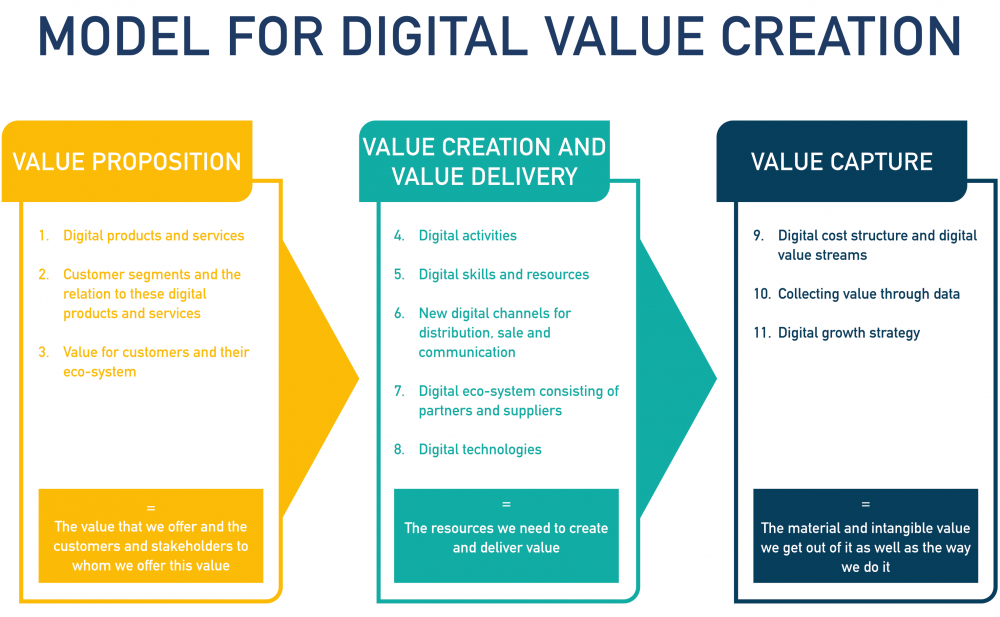Lean Canvas Model
2012
The Lean Canvas is an adaptation of the Business Model Canvas and it is specially designed for entrepreneurs. The canvas focuses on problems, solutions, key metrics and competitive advantages.
april 4, 2022
The module introduces the overall understanding of a business model, which is the basis for working with the other modules. Here, the keyword is value – value for customers, users and the company behind the business model and other parties around the business model. The module also sheds light on how the vast majority of companies have several business models at the same time – which can be a source of greater readiness for change and help reduce financial risk.
Once you have made your Pre-analysis of the surrounding world and Pre-analysis of the company’s situation, and perhaps gathered inspiration from current or new via the Customer Analysis, you are ready to move on with the digital business model, which is the focal point of the entire process. However, to get started you need some fundamental knowledge about digital business models.
Very simplified, a business model can be described as:
The way in which a company creates value and makes money from it.
Thus, the business model describes how the individual pieces in the business are connected in a system. Please see the illustration Model for digital value creation below.

Value proposition, value creation and delivery as well as value capture are common elements across the various tools you can use to describe your company’s Current Business Models or to design New Digital Business Models:
You must ensure that your business model offers value for a specific customer segment or user group. What is perceived as valuable, of course, depends on who the recipient is. Often, value can be a solution to a specific problem or something that meets a need and thereby provides value to the recipient.
In order for the customer or user to achieve value via a digital product or service, a number of practical activities take place take place along the way. Thus, in the business model, you must also explain the practical steps; for example, what resources, knowledge and technology must be used in order for you as a company to be able to develop or produce the solution. Likewise, the digital solution must be delivered to the customer; therefore, a need for a network of partners, a distribution system or something else may arise.
Last but not least, the description of the business model must explain how the company can capture value through its activities. Here, it may vary what value you as a company want to achieve with the business model. Examples could be profit, more customers, a greener bottom line or knowledge in terms of data as part of your digital growth strategy.
It is important to understand the flexibility that can be obtained by working with your business model, or rather, your business models. If you set up a business model every time you offer a solution (value proposition) to a customer segment, it enables you to view your business more flexibly. Often, a company will thus have products and services, each of which either targets different customer segments or different needs within the same segment. Therefore, it also makes sense to have different business models for different products and services.

Having multiple business models also helps to reduce risks in the business, as it allows for greater agility where new business models can be developed and tested, while others remain active. Therefore, when you try something new, you do not stake everything on one throw. Likewise, business models that have proven less profitable may be phased out while others take over. Business models that relate to the company’s core products can be combined with new digital services in business models that can bring existing customers closer to the company and provide competitive advantages to new customer segments.
On this website, you will find a number of modules that introduce you to the various tools for developing, testing and implementing a new digital business model from the company’s current position. If you need inspiration, you can take a look at our case studies that provide examples of innovation in existing business models.
When you are ready to work with your own business model, a good place to start is with a Pre-analysis of the surrounding world to gain insight into the opportunities and threats that surround your company. If you have already visited this module along with the modules Customer analysis, Pre-analysis of the company’s situation and Service Design, you can go directly to the module Insight into Current Business Model or Design of a New Digital Business Model.

The content elements above have been developed through two projects:
‘Digital Business models for the Future’ by Aarhus University, Aarhus School of Marine and Technical Engineering and Danish Technological Institute supported by The Danish Industry Foundation. The material from this project has been adopted in alignment with CC BY-SA 4.0
‘EU-IoT’ by Aarhus University, Martel Innovate, Netcompany-Intrasoft, Fortiss, BluSpecs and funded by the Horizon 2020 Framework Programme under topic ID ICT-56-2020, grant ID 956671.

